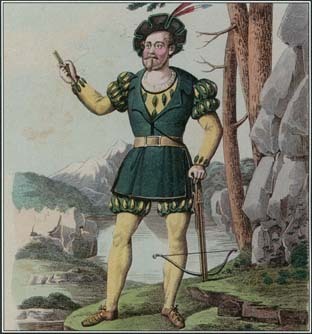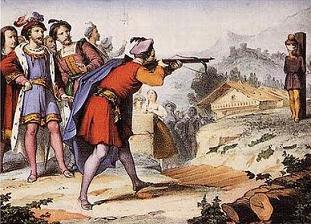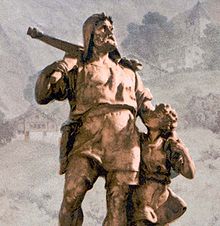The story of William Tell is so familiar to so many people that it must have been true, except that little concrete evidence of the man or his exploits exists.
 As the popular telling has it, Tell hailed from a village called Bürglen, in the canton (similar to county) of Uri, in Switzerland. The main town in Uri was Altdorf, and the main government official there in the early 14th Century was a man named Gessler, who was said to be a bailiff employed by the Habsburg dynasty, headquartered in nearby Austria.
As the popular telling has it, Tell hailed from a village called Bürglen, in the canton (similar to county) of Uri, in Switzerland. The main town in Uri was Altdorf, and the main government official there in the early 14th Century was a man named Gessler, who was said to be a bailiff employed by the Habsburg dynasty, headquartered in nearby Austria.
Gessler had sought to stamp his authority on the people of Altdorf by placing a hat on top of a pole in the town square. People who walked by the pole were supposed to bow to the hat on the pole, to show their fealty toward the bailiff and, by extension, the Austrian government. Failure to do so was classed as treason.
On a certain day–and many sources say it was November 18, 1307–William Tell and his son walked from their home in Bürlgen to Altdorf and then walked straight past the hat-on-a-pole without bowing or otherwise acknowledging the Habsburg authority.
Tell and his son were not the only ones around at the time, and their refusal to show fealty was noticed and reported. Authorities arrested Tell; and Gessler, the bailiff, threatened to execute him and his son unless Tell could prove his skill as a marksman. Tell was a hunter and a mountain climber, and his skill with a crossbow was well-known.
 His task to avoid execution was to shoot an apple off his son's head at 100 paces, in front of an audience that included the bailiff and other authority figures.
His task to avoid execution was to shoot an apple off his son's head at 100 paces, in front of an audience that included the bailiff and other authority figures.
Tell agreed to prove his marksmanship, endangering his son's life in the process. Remarkably, he split the apple but didn't harm his son. He then informed the bailiff that if the first bolt had killed his son, he would have shot the bailiff with a second bolt that he had hidden in his cloak.
Hearing this, bailiff revoked his promise to let Tell go free and instead slapped him in irons and put on a boat to be shipped off to a castle dungeon in Küssnacht. Gessler and his henchmen accompanied Tell on the boat trip across Lake Lucerne. When a sudden storm threatened to capsize the boat, Gessler allowed Tell, who was a big powerful man who knew the lake well, out of his restraints so he could pilot the boat to shore. Not trusting the bailiff, Tell brought the boat close to shore, then lept out and pushed the boat back out into the storm.
Tell escaped into the hinterlands. Not long after, Gessler and his henchmen escaped the storm. They met up again with deadly consequences.
Tell was lying in wait near the Küssnacht castle, in a narrow pass called the Höhle Gasse. It was there, as Gessler and his henchmen marched unawares toward the castle, that Tell used his other crossbow bolt to shoot Gessler dead.
Tell later met up with others unhappy with Habsburg rule, and they swore The Oath of the Swiss confederates on the Rütli, a mountain meadow next to the lake. This became the basis for the Swiss Confederation, an independence movement that threw off the Habsburg yoke.
The first written account of the William Tell story was published in the late 15th Century–more than 100 years later than the events described–in the White Book of Sarnen, a collection of medieval manuscripts put together by a scribe named Hans Schriber. A subsequent written reference to Tell appears in Chronicle of the Swiss Confederation, a 1507 book by Petermann Etterlin.

About this time as well, Tell started featuring in ballads of the beginnings of the Swiss Confederation. One of the most famous of these ballads was the Tellenlied, which dates to the 1470s.
A drama followed a couple of decades later, and then came the first mention in a history book, the Chronicon Helveticum, published by Aegidius Tschudi in 1734. Much more famous adaptations of the story came in 1804, in the play Wilhelm Tell by Friedrich von Schiller, and in 1829, in an eponymous opera by Gioachino Rossini.
The story is certainly a well-known one. Landmarks commemorate the various events in the story:
Fun Fact
The theme song to a late-20th Century TV show, The Lone Ranger, featured the last part of Rossini's overture to his opera William Tell.
|
Some scholars have noticed in Tell's story striking similarities with that of the 10th Century Danish King Harald Bluetooth and one of his chieftains, a man named Toko. As that story went, Toko boasted to his king that he could do anything with a bow and arrow, even shooting an apple off the top of a pike several yards away. The king made Toko live up to his boast by shooting an apple off not a pike but the head of Toko's own son. This story further said that Toko had promised to kill his king if the first shot had killed his own son and that, in a later revolt, it was Toko who killed King Harald, with an arrow. Stories of a tremendously skilled marksman pop up in other Scandinavian legends.
Many historians date the Oath of Rütli to 1291, which was 16 years before William Tell's famous apple-shooting incident. If Tell was one of the people taking the oath in that year, then his act of defiance against a Habsburg bailiff in 1307 could be seen as even more of a provocation.
Further study has found that the original reference did not give a first name for either William Tell or his son. Later versions of the story said that his son was named Walter and that he shot the crossbow bolt from 120 paces away (not 100, as in the original version). The Chronicon Helveticum ends Tell's story with his death, in 1365, while trying to save a drowning child.
Some versions of the story make it a bow and arrow that Tell uses to strike the apple from his son's head.